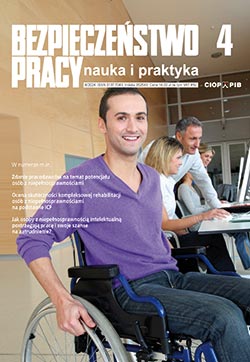Selection of filtering respiratory protective devices for protection against nanoparticles
mgr Krzysztof Makowski
This article provides basic information about protection of respiratory system from aerosols that contain nanoparticles. Nanoparticles, with which we are increasingly dealing not only in work, as a result of the development of new technologies, but also in everyday life. The growing number of hazards absorbed through the respiratory system, related to the development of industry, new technologies and pollution of the environment in which we live, is nowadays a situation that we must face more and more often. The growing awareness of users of respiratory protective devices regarding existing hazards is also extremely important from the point of view of public health. We have already got used to the image of people in filtering masks on the streets of our cities, protecting against smog.
The history of purifying air for breathing goes back to the Roman Empire, where in the first century AD most probably the first time a respiratory protection was used. I`. Respiratory protection through the use of individual solutions in the form of respiratory protection equipment, in today's world is becoming a more common phenomenon. It no longer applies only to employees but also to private individuals.
Bacterial enteropathogens in occupational environment of wastewater treatment plants
dr inż. Agata Stobnicka-Kupiec
Wastewater is a potential epidemiological threat. Therefore, wastewater treatment plants’ workers may be exposed to bacterial enteropathogens during their occupational activities. The source of these biological agents may be both bioaerosols, emitted during technological processes, as well as contact with sewage, sewage sludge or contaminated surfaces. Exposure to bacterial pathogens may cause various diseases and adverse health effects, including both intestinal and parenteral infections. In this light, reliable risk assessment and appropriate preventive measures are key to occupational hazard prevention among this group of workers.
Work-design – the need for a redefinition of an approach to the work-design problem
dr Mateusz Hauk
The main objective of this article was to review „work-design” theories as well as changes in the labor market that lead to a redefinition of the approach to work-design. The article describes these concepts and approaches to work-design (both those known in Poland and those with less attention given in Polish literature), which enjoyed the greatest interest in the management and work sciences and for years shaped practical guidelines: Management Theory by Taylor, Herzberg Theory, JCM Model by Hackman and Oldham, Warr's Vitamin Model, Job Demands – Control Theory by Karasek, Interdisciplinary Approach to Work Design by Campion and Thayer. The most important changes on the labor market were also described, which influenced the need to expand the list of features of work important from the point of view of employee well-being, indicating at the same time the need to design work from the perspective of not only the individual but also the team, taking into account the impact and co-responsibility of employees.




























